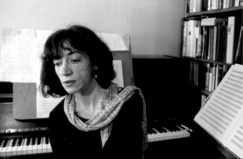|

photo: Algimantas Aleksandravičius
|
After the astonishing premiere of the Second Symphony by
Onutė Narbutaitė at the Gaida Festival in 2001, two years of silent work passed. That was the time necessary for the composer to implement her most recent idea, the cycle of three symphonies
Tres Dei Matris Symphoniae, the monumentality and scope of which could match the oratorio
Centones meae urbi written in 1997. The world premiere of this work at Konzerthalle "C. Ph. E. Bach" in Frankfurt am Oder on March 5, 2004, will serve as an introduction for the Musikfesttage an der Oder Festival and will be performed by
Grosser Chor der Singakademie Frankfurt, Aidija Choir and
Brandenburgisches Staatsorchester under Robertas Šervenikas.
How did you come over the idea to start another huge symphonic work just after the amazing success of your Second Symphony?In 2000, under initiative of Brandenburgisches Staatsorchester Frankfurt, my oratorio
Centones meae urbi was performed in Frankfurt and Cottbus, together with Aidija Choir and conductor Robertas Šervenikas. A year later, the orchestra manager offered me to compose a large-scale work for orchestra and Singakademie Frankfurt Choir. Again, Aidija Choir and conductor Robertas Šervenikas were invited to Frankfurt to perform its world premiere. The request was that the duration of the new opus covered all opening night of the Musikfesttage an der Oder Festival and its subject related to various aspects of liturgical music. Not necessarily only forms of Catholic Mass, Evangelical Passion or other elements associated with Orthodox or Jewish liturgy could be employed; broader interpretations of religiousness could be presented as well. Thus, I started thinking of a religious theme.
Was it the first time you dealt with the religious subject? In what way does it appeal to you?There are quite a few religious aspects in my oratorio
Centones meae urbi, as well as in some of my instrumental works, such as
Interludium and, especially,
Melody in the Garden of Olives. It is very exciting to work on subjects with vast and rich history that were already interpreted by many artists, and try to find your own way. What appeals is that such a work evokes a large field of associations and you can play with it. Such particular way of communication to the audience reveals many different layers that are inevitably bound not only to the structures of the work, but also to our common existential experience. Nevertheless, the religious subject seems to me demanding personal, intimate choice and attitude as well.
How would you define the genre of your new work?
The title of the work is Tres Dei Matris Symphoniae (Three Symphonies of the Mother of God). Three movements of it, Angelus Domini, Bethleem and Mater Dolorosa, depict three major episodes of Mary's life marked by crucial moments of life of Jesus Christ: Revelation, Nativity and Crucifixion. I used the term "symphony" for the title not accidentally: I was composing a symphony, not an oratorio. Here, the role of the choir is much less significant than that of the orchestra, albeit very important in some episodes. Besides, the concept of a symphony in the sense of a consonance, harmony, was willingly employed by Hildegard von Bingen, the text by whom I used for the final Oratio (Prayer). I intended this meaning as well.
In your work, did you follow any canonical tradition of representation of Mary? Or maybe it served as a sign for Lithuanian identity (after all, Lithuanians often call their homeland "the Land of Mary")?
I approach the image of Mary in a very personal way. It has to do more with existential contemplations and empathies rather than with canonic ritual. Besides, to my mind, this personal approach is the most important aspect of religion, at least in Christianity. The composition of the work itself is non-traditional. I was inspired by classical and ancient music, medieval painting and contemplations on this matter of various times. In the beginning of the score I drew the symbol of the Holy Trinity, a triangle that here also symbolizes three movements of the work: the downward line goes for Revelation, horizontal line represents Nativity, and the upward one symbolizes Crucifixion. All forthcoming musical events lie encoded in the first part, as the Revelation of the Angel to Mary presages all future events. I tried to avoid illustrative depiction; I was composing music beyond its limits, by 'olden' and universal means, such as proportion between consonance and dissonance, alternation of chiaroscuro, intimacy of solo instruments juxtaposed with tutti streams. Here you will find some symmetry of proportions and overarching repetitions. Possibly, the image of Mary embodied in my music is not quite traditional, if we consider the usual, somewhat one-dimensional lyricism of Mary as the tradition. On the other hand, some of my musical choices were inspired by traditional elements of iconographic symbolism.
© Audronė Žiūraitytė
Lithuanian Music Link No. 7

